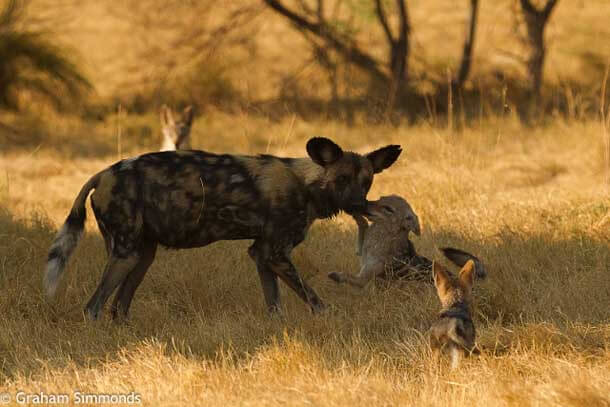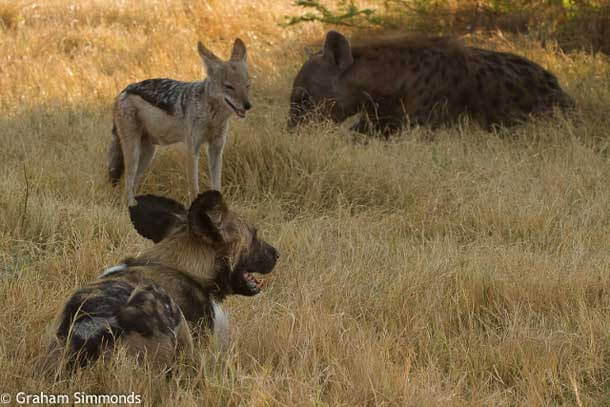Solo the Wild Dog and Turura 2 an Ethiopian wolf
Teaching us about family..
Solo the Wild Dog (*) and Turura 2 an Ethiopian wolf
The African wild dog is one seriously social animal. Like its North American cousin, the gray wolf, a wild dog’s life revolves around the complex social hierarchy of the pack. But unlike wolves, African wild dogs exhibit what almost seems like altruistic behavior when it comes to their pack mates. At a kill, the youngest dogs eat first, followed by the subordinate members of the pack. Everyone takes their turn and if there isn’t enough to go around, the hunt begins again. When the hunters return to the den they regurgitate meat for those that stayed behind, including pups and members of the pack that are too sick, injured, or old to hunt. The instinct to be a part of, and support, a pack obviously runs incredibly deep. So what happens when a wild dog loses its pack?
* Not to be confused with Solo: The Story of an African Wild Dog, a book by Hugo van Lawick.
Thanks to a female wild dog named Solo, who lived on Mombo Island, in the heart of Botswana’s Okavango Delta, we know the surprising answer to this question.
Up until recently the island was a wild dog stronghold. But competition from lions and other predators decimated the dogs’ numbers until all that remained was a pack of three – two males and Solo. Eventually, the two males also disappeared and Solo was alone. She spent six months hunting on her own, evading predators, and calling out occasionally for her missing mates. Everyone thought that if Solo survived long enough, she would eventually wander off and try to join a new pack. But something truly unexpected happened instead; Solo stayed on the island and formed a new pack of sorts – with some young spotted hyenas. Normally wild dogs and hyenas are fierce competitors, so local observers were surprised, to say the least, by this new alliance. It got even more interesting when Solo started hanging out with several different families of black-backed jackals. Soon, a ragtag assortment of hyenas, jackals and one wild dog could be seen hunting together on the island. The arrangement worked. African wild dogs are notoriously effective hunters, so Solo’s new pals had a more stable supply of food than they had before. And Solo no longer had to evade lions and other predators on her own. Ultimately, Solo’s instinct to be a part of a pack was stronger than her instinct to only associate with others of her kind.Courtesy: Matt Kareus of iSafari
THE STORY OF SOLO (WILDERNESS SAFARIS BLOG - Feb 2014)
It has been more than two months without a sighting of Solo, the lone wild dog who became famous for ‘befriending’ jackals, protecting and feeding them at Mombo – something that guests and staff alike have been privileged to enjoy for the past four-and-a-half years.
Solo was part of a larger pack that used to terrorise the floodplains around camp – impala, red lechwe and kudu were all easy prey to their speed and agility. That pack was sadly reduced to three when they were caught in an ambush set by lions and most of the surviving dogs left the area, with three deciding to stay. Shortly after this the trio was reduced to one: Solo. The guides were unsure if the other two had been killed or simply moved off in search of their pack members, but Solo was not leaving, she was staying put. At first, it was thought that her condition would deteriorate due to not being able to hunt in a pack as she had her whole life; however, it was soon apparent that her skill was no match for her prey, mostly impala. Solo, being alone, had the advantage of not having other dogs break cover or alert the prey. She could wake up, yawn, stretch and set off on the hunt, often bringing down her prey within a few hundred yards of her resting spot. Whilst her survival was amazing, what was even more fascinating was her desire for companionship. She started taking it upon herself to share her kills with the local black-backed jackals and, even more so, their offspring. This phenomenal interaction was caught on camera and documented by Brad Bestelink in Solo, A Wild Dog’s Tale. Further to her relationship with the jackals, in which she eventually connected with at least four known parent couples, was her interaction with hyaena. The hyaena would tolerate her and even greet her in the late afternoons at the airstrip before watching her set off on her hunt. They would lope as close behind as they could, knowing that she would be successful and they would be able to bully her off and get a meal to themselves. This amazing change in temperament towards a wild dog is uncommon as hyaena and wild dog usually tear into each other whenever possible. It was impossible not to have a smile on our faces as we would watch the greeting rituals and Solo bounding off with a few hyaena and a couple of jackal in hot pursuit. Her connection with the jackals was so strong that she would slow her hunts at times, waiting for the shorter-legged canines to catch up. At night, before lying down, she would call to see if her companions were near, a haunting call that would resonate around the area. The last sightings of Solo happened around the same time that a pack of five bachelor wild dog entered the area. It is not known if the pack chased her off or, as our first thoughts were, whether she joined up with them. However, having the nature she did, she may have shown signs of aggression to them as they neared the jackal den and they could have responded. She would be no match for five young males. The males have been seen since and unfortunately their numbers have not risen to six. Another hypothesis is that time simply caught up with her. She was a mature female when the pack disbanded and so she could have already been in her twilight years. Slower reaction times when it came to lions, tussling with a large male leopard, the wrong step and a snake bite, so many different options can be played over and over again in one’s head, the answers unknown, the questions limitless. A final thought could also be that she simply moved out of the area. Fires came through the northern part of the concession just prior to our last sightings of her and this cleared out a lot of the dead grass. With the new area now lush, flatter and green, it attracts herds of impala, red lechwe and zebra. She may have simply moved territory to escape the hyperactive playfulness of the five young wild dog and for a quieter life with other jackals. There is still hope that she will be seen back in the immediate area as the seasons change with her band of merry companions following. While we do not know where or how she went, what we do know is that we were all the better for having been privileged to witness this remarkable story play out in front of us, immortalised in our memories, in photos and even on film. Solo: a solitary wild dog changing perceptions of the remarkable wild world we live in.Turura 2 - an Ethiopian wolf
AMONG THE RUGGED LANDSCAPE OF ETHIOPIA’S BALE MOUNTAINS, the old wolf emerged from the den, six fuzzy pups weaving between her paws. Despite the threads of gray woven into her fur, her vivid red-orange frame still burned brightly against the blue sky. This wolf, known as “Tarura 2,” is one of approximately 500 Ethiopian wolves left in the wild. As Africa’s most endangered carnivores, the Ethiopian Wolf Conservation Program’s (EWCP) efforts to protect their fragile populations are critical to their survival.
Tarura 2 was one of the only survivors after her original pack was devastated by rabies. When EWCP found her in 2011, she became part of their first oral vaccination trial. The spread of diseases like rabies from local domestic dogs to wolves is a serious threat, so each year, EWCP vaccinates over 3,000 domestic dogs and as many wolves as possible. Their intervention helped Tarura 2 survive four more rabies outbreaks and rebuild her pack. Data collected from the Tarura pack taught EWCP more about wolf behavior, improving the effectiveness of their oral vaccination program. Tarura 2 produced 51 pups over the next decade, her pack growing so large that three new packs eventually split from it. This year, EWCP recorded 10 litters of pups born among these offshoot packs. In her old age, Tarura 2 now looks after her grandchildren while their parents hunt. She carries a remarkable legacy and has contributed more to the survival of the Bale Mountain wolves—the most critical population of the species—than any other wolf. Tarura 2 is a walking example of the monumental difference that EWCP’s vaccination program has made for Ethiopian wolves.Courtesy: Wildlife Conservation Network
ARTICLES OF INTEREST:
Solo: The Wild Dog - A+B Films (video trailer).
A Wild Dogs Story - SOLO (documentary video).
Go back to: Families & Species Ambassadors


